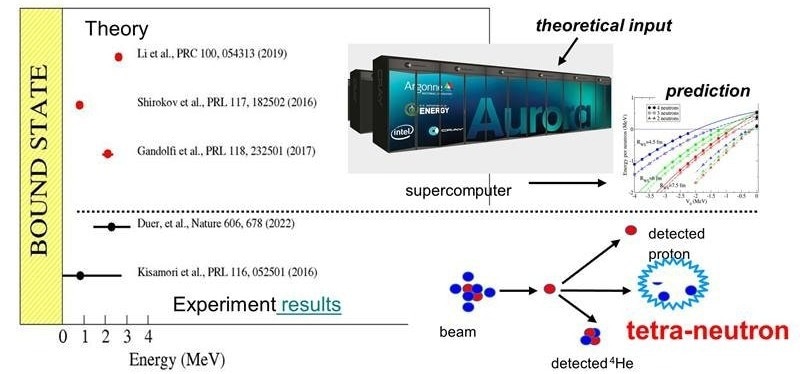Reviewed by Mila PereraSep 26 2022
For several years, the presence of the tetraneutron has perplexed nuclear theorists and experimentalists.
 New experimental evidence of a tetraneutron agrees with Quantum Monte Carlo predictions and other calculations. The black symbols show experimental measurements. The red symbols correspond to selected theoretical predictions of a tetraneutron resonance. Image Credit: Stefano Gandolfi, Los Alamos National Laboratory
New experimental evidence of a tetraneutron agrees with Quantum Monte Carlo predictions and other calculations. The black symbols show experimental measurements. The red symbols correspond to selected theoretical predictions of a tetraneutron resonance. Image Credit: Stefano Gandolfi, Los Alamos National Laboratory
Except in the extreme conditions of neutron stars, atomic nuclei are made up of one or more protons and neutrons, so researchers have a limited understanding of systems that include neutrons alone.
The tetraneutron — a meta-stable nuclear system — can decay into four free neutrons. To comprehend the nuclei’s properties, the measurements and prediction of tetraneutron properties are crucial.
Since 2016, several studies by the NUCLEI collaboration have forecasted the presence of the tetraneutron system.
Researchers have now witnessed tetraneutrons in experimental conditions. Experimental measurements of the tetraneutron system can be inferred by measuring the missing energy in nuclear reactions.
These experimental outcomes are in accordance with the simulations made using parallel supercomputers.
The results will substantiate theoretical predictions and progress theoretical calculations. This is especially true of the newest experimental outcomes.
Nuclear physicists have a decent comprehension of proton-neutron and proton-proton interactions and understand how scattering data constrain these interactions from particle collision.
They still require direct validation of the forces among pure neutron systems. Understanding nuclear interactions among neutrons is essential in numerous fields, such as studying neutron stars and neutron-rich nuclei.
The tetraneutron resonance discovery will pave the way for new challenges in nuclear physics. Specifically, new calculations and experiments will be crucial to assess scientists’ knowledge of nuclear interactions.
The collaborations of NUCLEI as part of the Department of Energy (DOE) Scientific Discovery Through Advanced Computing (SciDAC) program have performed a vital role in theoretical work in this field.
This study was financially supported by DOE, the NUCLEI SciDAC project, and the DOE Office of Science’s Office of Nuclear Physics and Office of Advanced Scientific Computing Research.